Webinar on Source Apportionment – 29 September 2025
This session will focus on tools and strategies for Source Apportionment, helping identify and quantify pollution sources in urban environments. Details and speakers will be announced soon. Date: September 29th, 10:00-12:00 CEST Format: Online (Zoom-Link) Agenda is as follow, you could also find it here 10:00- 10:05 Introduction by project coordinators (Xavier Querol) 10:05 - 10:15 Source apportionment based on 24h resolution PM chemistry data (Fulvio Amato) 10:15 - 10:25 Source apportionment based on high-time resolution organic aerosol measurement (Marta Vía) 10:25 - 10:35 Source apportionment based on high-time resolution trace elements measurements (Mannos Manousaka) 10:35 - 10:45 Source apportionment based on datasets with different time-resolution (Marta Vía) 10:45 - 10:55 BC source apportionment (Marjan savadkoohi) 10:55 - 11:05 UFP source apportionment (Meritxell García) 11:05 - 11:15 OP source apportionment (Gaëlle Uzu) 11:15 - 11:25 VOC source apportionment (Xavier Querol) 11:25-11:35 Break 11:35 - 12:00 Q&A session (All)









